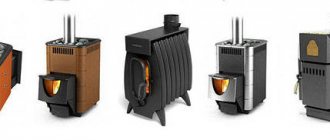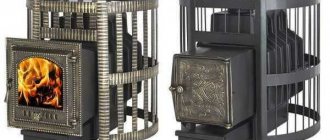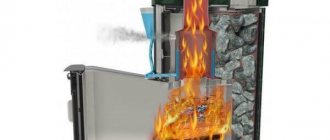Angara stove 2012 - the ideal stove for a Russian bath
If you are a lover of the Russian bath and are looking for a reliable and durable wood-burning stove for it, we recommend you the Angara 2012 stove, which has proven itself excellent over the past few years.
In this article we will talk in detail about all the features that made the TMF Angara 2012 stove so popular among connoisseurs of a real Russian bath. The Angara 2012 sauna stove series includes products of various modifications and different capacities (more details about the modifications can be found at this link), designed for steam rooms with a volume of up to 18 m3 (find out how to correctly calculate the volume of a steam room).
All stoves from the TMF Angara 2012 series are wood-burning and are designed for the “Russian bath” mode, which means that they are equipped with a closed heater and heat the room no higher than 60–70 °C, providing the much-desired light steam.
Now let’s take a closer look at how this can be achieved.
General characteristics of Angara stoves
Nowadays, one of the most common and popular models of sauna stoves is the Angara stove produced by the Termofor company.
Kamenki at the exhibition
These wood-burning heaters are made mainly from alloy steel and cope well with continuous loads. The steel alloy contains 13% chromium, which provides excellent anti-corrosion properties. At the moment, the company produces a huge number of models of sauna stoves. Each potential buyer will be able to find the most suitable model for his steam room. “Angara” combines high quality and affordable price.
There will be high-quality steam in the steam room, since the “Angara” heats the stones to a high temperature. All water that falls on the stones quickly evaporates. The walls of the heater have a curved shape, which allows for greater contact between stones and chimney ducts. The heat from burning wood can be used thanks to a heat exchanger, due to which the stones are evenly heated.
The body of the Angara bath stoves is made of special heat-resistant steel. Such material can extend the service life and increase resistance to mechanical damage and deformation. The grate bars of the combustion compartment are solid cast, made of cast iron. To prevent radiation from emanating from the walls of the hot furnace, the firebox is placed in a special protective casing coated with heat-resistant paint. Among other things, the casing provides excellent protection against corrosion and does not oxidize. The owner of the bathhouse will be able to manually set the required temperature.
If necessary, the furnace can be connected to water registers - heat exchangers. For ease of installation, given a certain room layout, “Angara” stoves are available for sale with a left- and right-hand heat exchanger arrangement. The liquid will heat up due to its own recirculation. For any stove model, you can purchase a samovar-type liquid heater, which is installed on the chimney pipe.
Closed heater
The Angara 2012 stove is intended for a Russian bath and is not suitable for a Finnish sauna precisely because of the closed cylindrical heater located above the firebox and surrounded by a vortex reheating chamber, separating it from the open heater. This improved design helped to achieve redistribution of heat from the burned fuel, primarily in the area of the closed heater. Thanks to this, the stones in it are heated by circular streams of fire up to 600°C quickly and evenly .
To supply water, a funnel with a narrow pipe is used, which delivers water to the very center of the heater. This is where the effect that true connoisseurs of the Russian bath love so much is achieved - the so-called light steam without overdried and overheated air. Such valuable lightness is acquired as steam passes through the entire closed and part of the open heater, during which it is split into even smaller and lighter particles.
A closed heater - together with a small open one - can hold up to 70 kg of stones.
Advantages: Normal appearance, there is a heat exchanger. Relatively inexpensive. Disadvantages: When heated: the door lock jams, the fireclay brick cracks, the steel leads from below under the firebox brick. Bad thermal paint. Very weak heat exchanger.
I wanted to buy a fireplace and accidentally came across this model. The heat transfer power of the fireplace itself is 9 kW, as well as the heat exchanger with a heat transfer of 7 kW, as the seller promised. The instructions say that this fireplace has a long burning time and consumes 3 kg of wood per hour. This played a decisive role in choosing this product.
The stove is really elegant. That's all! No miracles. An ordinary potbelly stove with glass and a heat exchanger, without smoke circulation, that is, from the firebox directly into the chimney through the heat exchanger. In principle, a fireplace cannot have high efficiency. Another thing is that you can regulate the combustion speed/temperature. Suitable as a decoration, it is nice to look at the flame, especially in winter, to quickly raise the temperature in the room and as an addition to the main boiler. It cannot be used as a boiler due to low efficiency and a weak heat exchanger. The radiation power of the fireplace itself, 9 kW, is similar to the truth, but the power of the heat exchanger... not quite. In order to release a power of 6 kW into the coolant, you need to fill the entire firebox with firewood and open all the dampers to the maximum, and you won’t have time to throw firewood into a steam locomotive, not 3 kg per hour but probably 8. The real power is 4-4.5 kW with normal combustion, and low combustion is when all dampers are closed, this is 2-2.5 kW/h. If you have an electric boiler and they work in pairs, then it will not be superfluous if 4 kW goes into the system, provided that you heat for 3 hours, this is 4.5 rubles * 4 kW * 3 hours = 54 rubles saving electricity in the coolant. But if you have natural gas heating, then you simply cannot buy a fireplace with a heat exchanger. Due to the violation of the aesthetic appearance of the pipes that should be led to the fireplace.
Important for the heat exchanger: Do not forget about the need to adjust the water supply to the “return” +55...60 degrees Celsius. To do this, we assemble a circuit with a distribution or mixing thermal valve:
And don’t forget about the relay thermostat to start the pump. And an uninterruptible power supply. If the fireplace is lit like a steam locomotive and the electricity suddenly goes out and there is no backup power or it suddenly fails, then with inactivity the temperature will rise to 120 degrees, the safety valve will work, steam will flow like from a steam locomotive into the room, and it’s good if there is water in the system and not antifreeze. What to do in the event of a power outage if there is no power to the pump: Without waiting for the coolant to reach 100 g P.1 Close the blower damper from below P.2 Close the pipe damper Then the flame will begin to go out. Place the coals with a scoop into a metal basin and overboard :)
Features of the Vitra model
Recently, among the Angara stove models, the Vitra stove has been in great demand. Users leave positive reviews about it.
Sauna stove model “Vitra”
The case is made in a classic style in the form of a rectangle with a loading door located on the front panel. The damper can be made of solid steel sheet or have an insert made of durable fire-resistant glass. The Vitra stove has a closed heater, which is located at the top and is divided into two parts. For excellent heating there are specialized openings with dampers. It is the dampers that are responsible for regulating the temperature of the heater.
The firebox has a cast iron grate bottom, which increases the service life of the stove. Thanks to this design, you can easily clean the stove from residual combustion substances that fall into the ash pan. The main advantages of the Angara Vitra stove include the following.
- When burned, fuel does not pollute the environment, as it is an environmentally friendly material. The air is saturated with the aroma of wood.
- Long service life. Since the stove is made of alloy steel and cast iron, it can last at least 25 years. These materials are able to protect equipment from corrosive processes and the negative effects of humid air in a bathhouse.
- A large heater can create soft and uniform steam.
- Installation of the stove is simple, there is no need to carry out preparatory work. The shielded housing does not require thermal insulation.
For the Angara Vitra stove, it is necessary to use volcanic cobblestones or river pebbles. It is these stones that can be subject to prolonged heating and are resistant to sudden changes in temperature. Before placing stones in the oven, they must be thoroughly cleaned of dirt and dried. After this, the stones are stacked, pressing tightly against each other.
How does it work
Before you begin installing the Angara 12 stove-fireplace, you must carefully study and read all the instructions and installation and operating manuals included in the kit.
In order to connect the firebox, you need to select a specific room and place in it. Stoves are not installed near or opposite windows and doorways, as drafts reduce their efficiency.
Before installing a fireplace, it is necessary to insulate the floor and walls around the fireplace. The basis for successful installation of the structure is the presence of a correctly connected chimney.
It is much more difficult to connect an Angara 12 fireplace with a water circuit and a heat exchanger. In order to cope with this task, we recommend studying the diagram below, which clearly displays all the key points:
As for the use of such a stove-fireplace, everything is quite simple and clear. When performing the first fire of the equipment, Meta specialists recommend placing several logs in the firebox and heating the fireplace for no more than two hours. This is necessary to preserve all the characteristics and quality of the paint coating applied to the firebox. In this way, the varnish coating can take on a solid form and remain in it forever.
During the first and several subsequent lightings of a new fireplace, an unpleasant odor may be felt. This is normal since the equipment is new. In this case, it is recommended to ventilate the room well and regularly while lighting the stove.
After the first kindling, it is also recommended to heat the structure a second time for no more than three hours. In this case, you can put half of the firewood in the combustion chamber, about 2-3 kilograms. The third and subsequent lighting of the fireplace is carried out according to the standard scheme.
In order to heat the house quickly enough, you first need to open the valves and wait until the rooms are completely heated. Next, the valves are closed, and thus oxygen begins to flow into the firebox in a limited manner. Ultimately, the equipment begins to work in economical mode, and the bookmarks thus last up to 8 hours of continuous operation.











